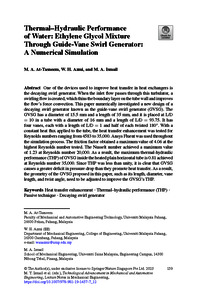At-Tasneem, Mohd Amin and Azmi, W. H. and M. A, Ismail (2023) Thermal–Hydraulic Performance of Water: Ethylene Glycol Mixture Through Guide-Vane Swirl Generator: A Numerical Simulation. In: 6th International Conference in Mechanical Engineering Research, ICMER 2021 , 26-27 October , Virtual, Online. pp. 159-170. (281799). ISSN 2195-4356 (Published)
![[img]](http://umpir.ump.edu.my/39277/1.hassmallThumbnailVersion/Intro-Thermal%E2%80%93Hydraulic%20Performance%20ofWater%20Ethylene%20Glycol%20Mixture%20Through%20Guide-Vane%20Swirl%20Generator%20A%20Numerical%20Simulation.png)
|
Image
Intro-Thermal–Hydraulic Performance ofWater Ethylene Glycol Mixture Through Guide-Vane Swirl Generator A Numerical Simulation.png Download (55kB) | Preview |
|
|
Pdf
Thermal–Hydraulic Performance ofWater Ethylene Glycol Mixture Through Guide-Vane Swirl Generator A Numerical Simulation.pdf Restricted to Repository staff only Download (292kB) | Request a copy |
Abstract
One of the devices used to improve heat transfer in heat exchangers is the decaying swirl generator. When the inlet flow passes through this turbulator, a swirling flow is created, which thins the boundary layer on the tube wall and improves the flow's force convection. This paper numerically investigated a new design of a decaying swirl generator known as the guide-vane swirl generator (GVSG). The GVSG has a diameter of 15.5 mm and a length of 35 mm, and it is placed at L/D = 10 in a tube with a diameter of 16 mm and a length of L/D = 93.75. It has four vanes, each with a length of L/D = 1 and half of each twisted 180°. With a constant heat flux applied to the tube, the heat transfer enhancement was tested for Reynolds numbers ranging from 4583 to 35,000. Ansys Fluent was used throughout the simulation process. The friction factor obtained a maximum value of 4.06 at the highest Reynolds number tested. The Nusselt number achieved a maximum value of 1.23 at Reynolds number 20,000. As a result, the maximum thermal-hydraulic performance (THP) of GVSG inside the heated plain horizontal tube is 0.81 achieved at Reynolds number 35,000. Since THP was less than unity, it is clear that GVSG causes a greater deficit in pressure drop than they promote heat transfer. As a result, the geometry of the GVSG proposed in this paper, such as its length, diameter, vane length, and twist angle, need to be adjusted to improve the GVSG's THP.
| Item Type: | Conference or Workshop Item (Paper) |
|---|---|
| Additional Information: | Indexed by Scopus |
| Uncontrolled Keywords: | Heat transfer enhancement ; Thermal–hydraulic performance (THP) ; Passive technique ; Decaying swirl generator |
| Subjects: | T Technology > TA Engineering (General). Civil engineering (General) T Technology > TK Electrical engineering. Electronics Nuclear engineering |
| Faculty/Division: | College of Engineering Faculty of Mechanical and Automotive Engineering Technology |
| Depositing User: | Miss Amelia Binti Hasan |
| Date Deposited: | 10 Nov 2023 07:44 |
| Last Modified: | 10 Nov 2023 07:45 |
| URI: | http://umpir.ump.edu.my/id/eprint/39277 |
| Download Statistic: | View Download Statistics |
Actions (login required)
 |
View Item |

